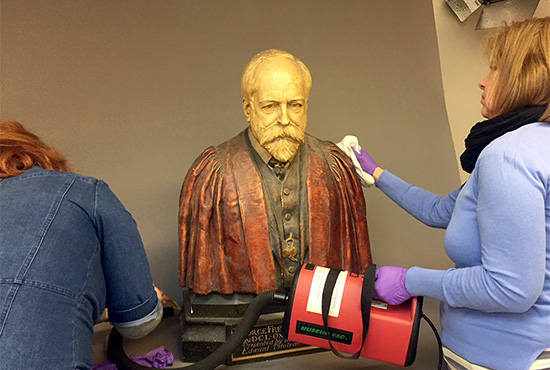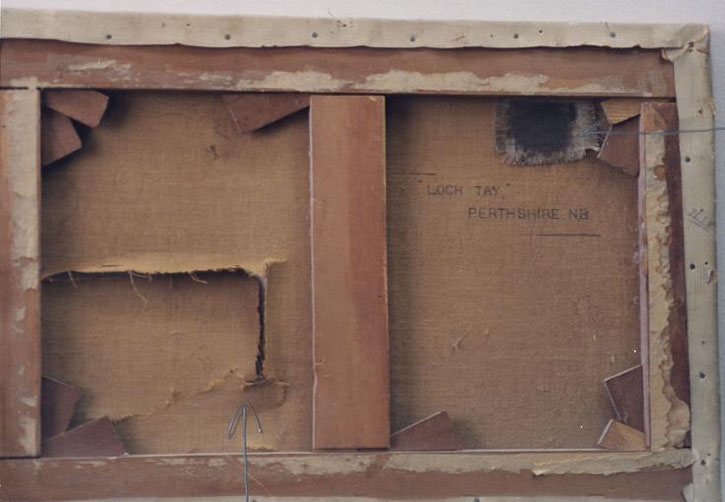
Damaging factors
Collections, historic interiors and exterior buildings all suffer from agents of deterioration that can, to a certain degree, be risk managed. Most damage, either mechanical or environmental, occurs through the following factors:
- Poor or careless handling and/or careless use.
- The use of wrong, ill-advised cleaning products.
- Over-cleaning or aggressive cleaning.
- Subjected to pollution from unsealed doors and windows, and dust caused by people, pollution and infrequent cleaning.
- Prolonged exposure to ultraviolet light (collections facing windows), and fluctuations in humidity and temperature.
- Mould, insect and pest infestations.
- And further risks such as loss and theft.
Discolouration to paintings
The most common sources of discolouration are surface dirt and the yellowing of old varnish. As mentioned above, yellowed varnish will darken a painting, disguise the artist's colours and distort tonal and colour contrasts. Surface cleaning and removal of old discoloured varnish are a major part of routine restoration work and usually relatively straightforward.
Bitumen disfiguration on a nineteenth-century oil painting
Physical damage to paintings
Tears and dents are usually the result of accidents. Serious tears may require the painting to be '(re)lined' (glueing a secondary canvas to the back of the painting), the tear first being flattened and realigned, after which any gaps are filled and the painting retouched and revarnished. Smaller tears can be repaired by rejoining 'thread-by-thread', avoiding the need for lining. However, these are expensive treatments and best avoided by careful handling and display.
The back of a nineteenth-century painting showing a tear and an old patch
Cupping and flaking in paintings
Cupping and flaking happen when the paint begins to lose adhesion with the underlying ground or support. This is usually due to repeated or rapid changes in temperature and/or humidity. A conservator can re-adhere the paint, so always try and keep flakes of paint that have fallen off or are loose. Never dust paintings if the paint is flaking.
Flaking oil paint
Mould
Mould would also be due to high relative humidity. It can irreversibly stain oil paint.
Distorted canvases
Canvases are traditionally fastened to a wooden stretcher with flat-headed nails or staples, and made flat with the use of wedges in the corners of the stretcher. Changes in humidity, loss of wedges, etc., will alter the canvas tension and may cause buckles or bulges in the surface. In severe cases, as a result of excess tension and the weakening of the canvas through age, the canvas may become detached from the stretcher on one or more edges, leading to severe distortions and possibly paint loss.
Split and warped panels
Painting on wooden panels was common, particularly up to the seventeenth century. Changes in humidity, especially excessive dryness, may cause wooden panels to split, especially if they are too tightly held in the frame, usually with resulting paint loss. Ageing and drying will naturally cause a plank to warp over time, and in the past attempts were often made to reverse warps by thinning the panel and attaching an additional timber framework or 'cradle' to the back, but this often caused more problems than it solved. Splits can be repaired and warping can be stabilised, although not removed, by professional treatment.
Artworks in an emergency
For the safeguarding of any collection and the people who work with and visit it, there needs to be a clear and workable Emergency Plan in place which is regularly reviewed and updated. The basic contents for a successful and active Emergency Plan should include the following:
- The address and contact details of the museum.
- The date the plan was written, its review date and where it is physically located so it can be returned.
- A description of what is considered to be an emergency.
- Emergency response procedures.
- Actions after initial confirmation of an emergency.
- Staff organisation and resources.
- An emergency contact list.
- Up to date floor plans, the locations to be used for the salvage operation, dynamic risk assessments for emergency situations and forms to record object damage.
- Emergency response materials and equipment and where to find it.
- Object salvage and first aid instructions.
- Additional guidance on such things as mould, air drying and freezing objects.
- A list of internal contacts.
- A list of external contacts including object specialists.
Along with your Emergency Plan, it is vital to have to hand materials and equipment which can help you safeguard any objects being affected. Keeping such things as the following in a backpack, away from the everyday housekeeping equipment, will make it instantly available and portable to an emergency:
- Plastic sheeting (cut to size or rolls which can be grabbed immediately).
- Absorbent cloths, rolls ('puddle pythons') and blotting paper.
- Dust masks.
- Disposable gloves in a variety of sizes.
- Hi-Vis (PPE) clothing.
- Kitchen Roll.
- A variety of tapes, including hazard tape, masking tape and parcel tape.
- Stationary including pencils, pens (archival, waterproof, marker), highlighters, erasers, post-it notes and tie-on labels.
- Resealable plastic bags, ranging in size from small to large.
- Set of screwdrivers, including security screwdrivers.
- Stanley or retractable knife and spare blades.
- Torch (head and/or handheld).
Information about further guidance and resources can be found on our page of useful links.